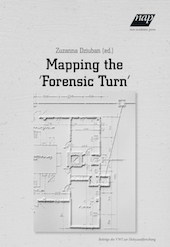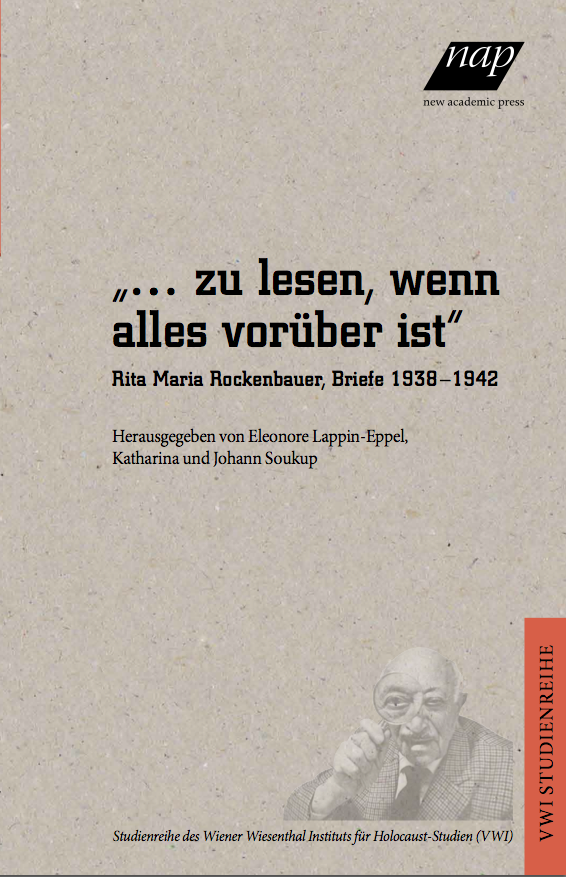 The Royal Hungarian Gendarmerie was one of the most important state institutions be tween 1881 and 1945. Its task was to preserve law and order in the countryside, to prevent peasant uprisings and Socialist agitation in the villages. In 1944, it also became the task the gendarmerie to concentrate and deport the Hungarian Jews to Auschwitz. The contemporary documents so far researched as well as the papers of the people’s court trials seem to clearly support the supposition that the gendarmerie, from the lowliest patrols to the gendarmerie district headquarters and to the detective subdivisions, readily took part in the collection and then the deportation of Jews. If deemed necessary, the trainees of the gendarmerie schools and training battalions assisted in the detection and collection.
The Royal Hungarian Gendarmerie was one of the most important state institutions be tween 1881 and 1945. Its task was to preserve law and order in the countryside, to prevent peasant uprisings and Socialist agitation in the villages. In 1944, it also became the task the gendarmerie to concentrate and deport the Hungarian Jews to Auschwitz. The contemporary documents so far researched as well as the papers of the people’s court trials seem to clearly support the supposition that the gendarmerie, from the lowliest patrols to the gendarmerie district headquarters and to the detective subdivisions, readily took part in the collection and then the deportation of Jews. If deemed necessary, the trainees of the gendarmerie schools and training battalions assisted in the detection and collection.
The first question I attempt to answer in this paper is why Adolf Eichmann and his ‘special ists’ primarily trusted the Hungarian gendarmerie in the spring and summer of 1944, when the Jews in Hungary were deprived of their property, herded into ghettoes and collection camps, and finally deported. This fundamental question thus relates to the crime, i.e. the deportation, and the role the gendarmerie played in the Holocaust. Second, I discuss the size of the gendarmerie, the number of those participating in the deportation, their connection to other agencies, above all the police and the administration, as well as their attitudes to ward the persecution of Jews and to deportations. Third, I investigate whether the gendarmes were cruel, as most of the survivors claim, or, on the contrary, whether they helped the persecuted, whether they protested and perhaps refused to obey orders, as former gendarmes claim, and as some people in Hungary are still trying to have the public believe. Finally, I investigate what they knew, what they could have known about the destination of the deportation trains, and about the true, final end of the deportations.
My other fundamental question relates to the punishment, to the accountability. What was the extent of the gendarmerie’s punishment, and how did it proceed? Was it a political show, or was their participation in the deportation the real reason for their punishment? How was evidence collected during the proceedings of the screening committees, the people’s prosecutor and the people’s court? Was torture resorted to, were the charges based on statements of witnesses, and/or were contemporary documents also attached to the indictments? The comparison to the criminal proceedings of other war criminals will be another important aspect of analysis.
Editorial
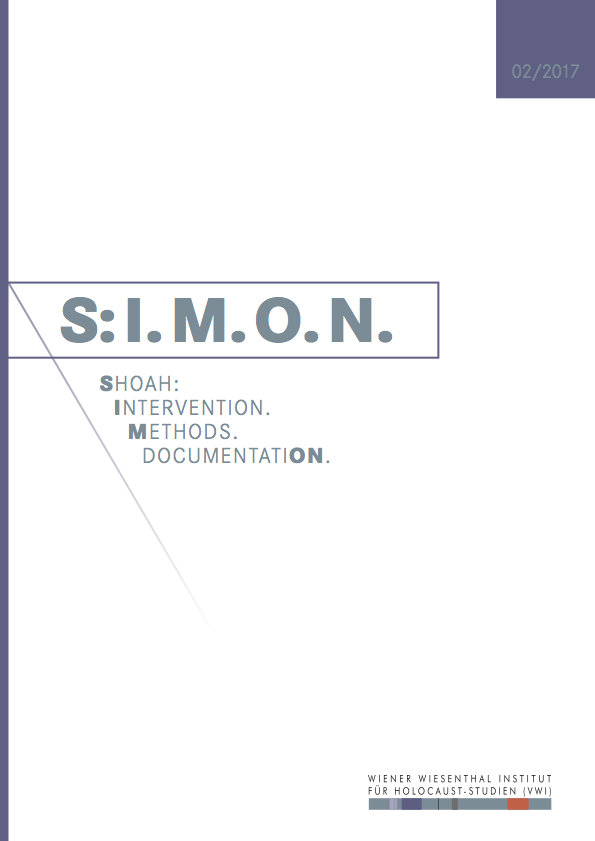 S:I.M.O.N. is an e-journal of the Vienna Wiesenthal Institute for Holocaust Studies (VWI). It appears twice a year in English and German language. S:I.M.O.N. aims at both a transnational and comparative history of the Holocaust and Jewish Studies in Central and Eastern Europe within the broader contexts of the European history of the 20th and 21st century, including its prehistory, consequences and legacies as well as the history of memory.
S:I.M.O.N. is an e-journal of the Vienna Wiesenthal Institute for Holocaust Studies (VWI). It appears twice a year in English and German language. S:I.M.O.N. aims at both a transnational and comparative history of the Holocaust and Jewish Studies in Central and Eastern Europe within the broader contexts of the European history of the 20th and 21st century, including its prehistory, consequences and legacies as well as the history of memory.
S:I.M.O.N. serves as a forum for discussion of various methodological approaches. The journal especially wishes to strengthen the exchange between researchers from different scientific communities and to integrate both the Jewish history and the history of the Holocaust into the different “national” narratives. It also lays a special emphasis on memory studies and the analysis of politics of memory. S:I.M.O.N. uses a double-blind review system, which means that both the reviewer’s and the author’s identities are concealed from each other hroughout the review process.
Shoah: The journal deals with the history of the Shoah from multidisciplinary, transnational and comparative perspectives. It seeks to integrate studies on Jews as well as on other groups of victims of the Holocaust, especially on Roma, and of so far less researched regions of (East) Central and (South) Eastern Europe.
Intervention. The journal reports on research projects and their transmission into public events. It also informs about current educational and remembrance programs.
Methods. The journal serves as a forum for the discussion of methodological approaches as, for instance, the everyday history, oral history, gender history, the history of violence, anti-Semitism and racism and the theory of memory and memory politics.
DocumentatiON. The journal contributes to critical approaches on using and interpreting archival materials in the 21st century.
Download the current issue S:I.M.O.N. 2017/2.
Articles
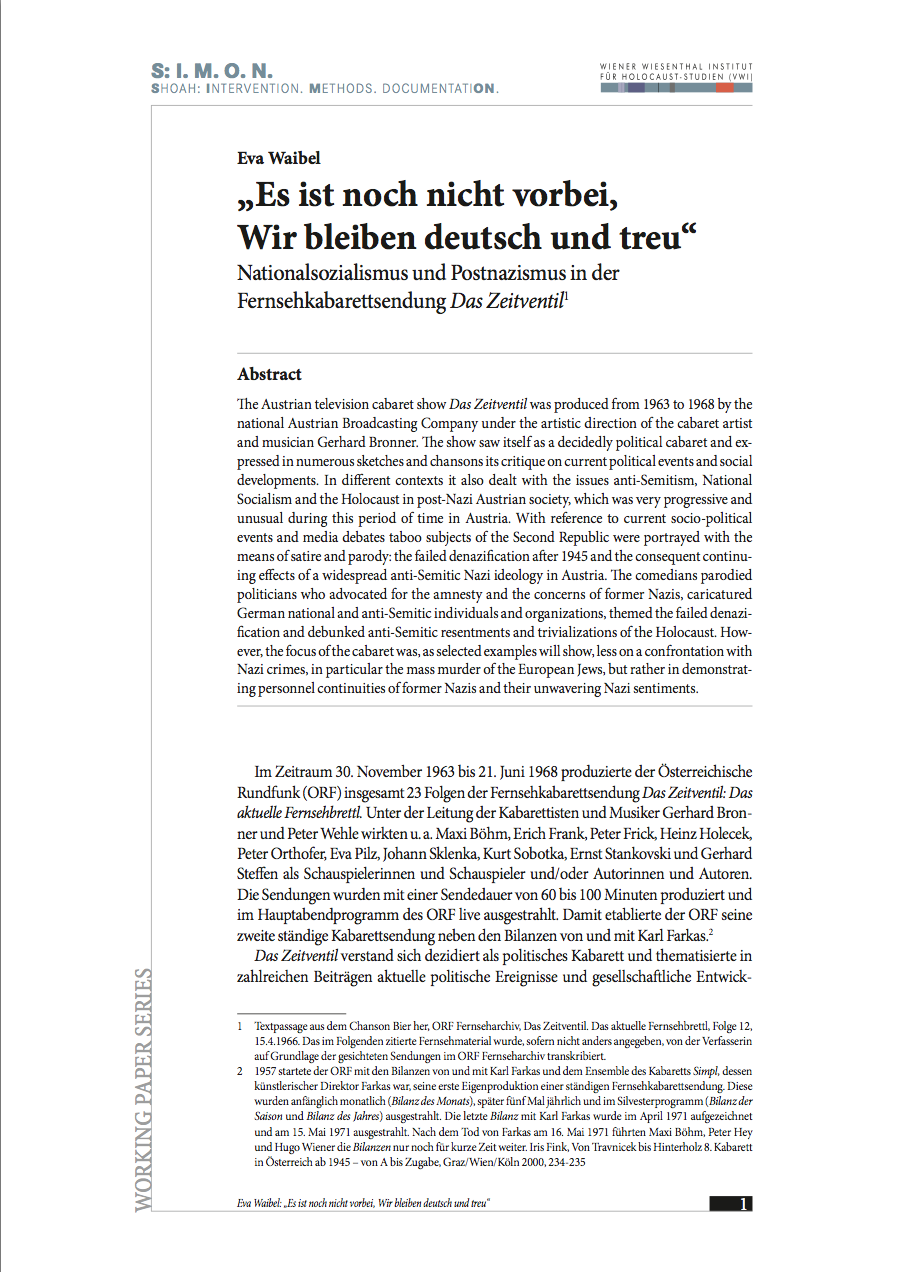 The Austrian television cabaret show Das Zeitventil was produced from 1963 to 1968 by the national Austrian Broadcasting Company under the artistic direction of the cabaret artist and musician Gerhard Bronner. The show saw itself as a decidedly political cabaret and expressed in numerous sketches and chansons its critique on current political events and social developments. In different contexts it also dealt with the issues antisemitism, National Socialism and the Holocaust in post-Nazi Austrian society, which was very progressive and unusual during this period of time in Austria. With reference to current socio-political events and media debates taboo subjects of the Second Republic were portrayed with the means of satire and parody: the failed denazification after 1945 and the consequent continuing effects of a widespread antisemitic Nazi ideology in Austria. The comedians parodied politicians who advocated for the amnesty and the concerns of former Nazis, caricatured German national and antisemitic individuals and organizations, themed the failed denazification and debunked antisemitic resentments and trivialisations of the Holocaust. However, the focus of the cabaret was, as selected examples will show, less on a confrontation with Nazi crimes, in particular the mass murder of the European Jews, but rather in demonstrating personnel continuities of former Nazis and their unwavering Nazi sentiments.
The Austrian television cabaret show Das Zeitventil was produced from 1963 to 1968 by the national Austrian Broadcasting Company under the artistic direction of the cabaret artist and musician Gerhard Bronner. The show saw itself as a decidedly political cabaret and expressed in numerous sketches and chansons its critique on current political events and social developments. In different contexts it also dealt with the issues antisemitism, National Socialism and the Holocaust in post-Nazi Austrian society, which was very progressive and unusual during this period of time in Austria. With reference to current socio-political events and media debates taboo subjects of the Second Republic were portrayed with the means of satire and parody: the failed denazification after 1945 and the consequent continuing effects of a widespread antisemitic Nazi ideology in Austria. The comedians parodied politicians who advocated for the amnesty and the concerns of former Nazis, caricatured German national and antisemitic individuals and organizations, themed the failed denazification and debunked antisemitic resentments and trivialisations of the Holocaust. However, the focus of the cabaret was, as selected examples will show, less on a confrontation with Nazi crimes, in particular the mass murder of the European Jews, but rather in demonstrating personnel continuities of former Nazis and their unwavering Nazi sentiments.
SWL-Reader
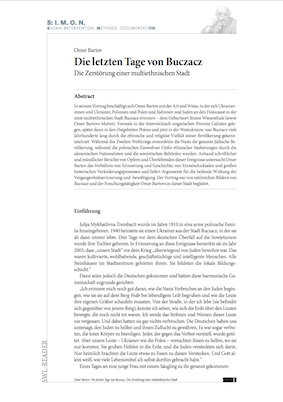 Omer Bartov's presentation addressed the way in which Ukrainians, Poles and Jews remember the Holocaust in the formerly multi-ethnic town of Buczacz, where Simon Wiesenthal was born (as was Omer Bartov's mother). Buczacz is located in what used to be the Austro-Hungarian province of Galicia, then became part of Poland's eastern lands and is now part of the Western Ukraine. For centuries, it was marked by its population's ethnic and religious diversity. During the time of the Second World War, the Nazis murdered the entire Jewish population; the Polish inhabitants fell victim to ethnic cleansing by Ukrainian nationalists and Soviet authorities. Omer Bartov used written and oral reports by victims and survivors in order to investigate the relationship between memory and history, between individual fates and grand historical processes of change. He argued for the healing effect of remembrance and coming to terms with the past. The presentation was accompanied by a wealth of pictures of Buczacz and of Omer Bartov's research activities in that city.
Omer Bartov's presentation addressed the way in which Ukrainians, Poles and Jews remember the Holocaust in the formerly multi-ethnic town of Buczacz, where Simon Wiesenthal was born (as was Omer Bartov's mother). Buczacz is located in what used to be the Austro-Hungarian province of Galicia, then became part of Poland's eastern lands and is now part of the Western Ukraine. For centuries, it was marked by its population's ethnic and religious diversity. During the time of the Second World War, the Nazis murdered the entire Jewish population; the Polish inhabitants fell victim to ethnic cleansing by Ukrainian nationalists and Soviet authorities. Omer Bartov used written and oral reports by victims and survivors in order to investigate the relationship between memory and history, between individual fates and grand historical processes of change. He argued for the healing effect of remembrance and coming to terms with the past. The presentation was accompanied by a wealth of pictures of Buczacz and of Omer Bartov's research activities in that city.
Events
Zoltán Halasi
Duschehubka
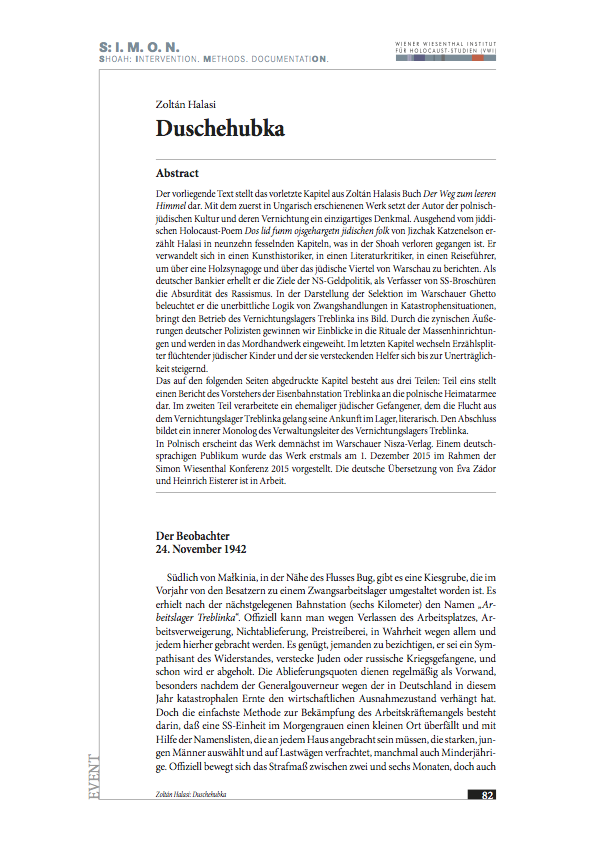 This text is the penultimate chapter of Zoltán Halasi's book Út az üres éghez (Road to an Empty Sky). With this work, which was first published in Hungarian, the author created a singular memorial to Polish-Jewish culture and its destruction. Setting out from the Yiddish Holocaust poem Dos lid funm ojsgehargetn jidischen folk by Itzhak Katzenelson, Halasi records what was lost in the Shoah in the course of nineteen compelling chapters. He takes on the grab of an art historian, a literary critic and a travel guide when he reports about a wooden synagogue and the Jewish quarter in Warsaw. In the role of a German banker, he illuminates the aims of the Nazi monetary policies, as a writer of SS brochures he highlights the absurdity of racism. Depicting a Selektion in the Warsaw ghetto, he shows the grim logic of compulsive acts in catastrophic situations, draws an image of the running of the extermination camp Treblinka. The cynical words of two German policemen provide an insight into the rituals of mass executions and introduce us to the craft of murder. The final chapter is an interplay of slithers of narrative by Jewish children on the run and by those who helped and hid them that borders on the unbearable.
This text is the penultimate chapter of Zoltán Halasi's book Út az üres éghez (Road to an Empty Sky). With this work, which was first published in Hungarian, the author created a singular memorial to Polish-Jewish culture and its destruction. Setting out from the Yiddish Holocaust poem Dos lid funm ojsgehargetn jidischen folk by Itzhak Katzenelson, Halasi records what was lost in the Shoah in the course of nineteen compelling chapters. He takes on the grab of an art historian, a literary critic and a travel guide when he reports about a wooden synagogue and the Jewish quarter in Warsaw. In the role of a German banker, he illuminates the aims of the Nazi monetary policies, as a writer of SS brochures he highlights the absurdity of racism. Depicting a Selektion in the Warsaw ghetto, he shows the grim logic of compulsive acts in catastrophic situations, draws an image of the running of the extermination camp Treblinka. The cynical words of two German policemen provide an insight into the rituals of mass executions and introduce us to the craft of murder. The final chapter is an interplay of slithers of narrative by Jewish children on the run and by those who helped and hid them that borders on the unbearable.
The chapter reproduced on the following pages has three parts: Part one is a Treblinka railway station master's report to the Polish Home Army. In the second part, a former Jewish detainee who managed to escape from the extermination camp Treblinka gives a literary treatment of his arrival at the camp. The final part consists of an inner monologue by the Treblinka extermination camp's director of administration.
The book will shortly be published in Polish at the Nisza publishing company in Warsaw. The German-speaking public was first presented with the work on December 1, 2015 at the Simon Wiesenthal Conference 2015. The German translation by Éva Zádor and Heinrich Eisterer is in progress.
Judit Molnár: Crime and Punishment? The Hungarian Gendarmerie during and after the Holocaust
„... zu lesen, wenn alles vorüber ist“
Rita Maria Rockenbauer, Briefe 1938 –1942
Wien 2014
Partituren der Erinnerung.
Der Holocaust in der Musik
Scores of Commemoration.
The Holocaust in Music
Wien 2015
Before the Holocaust Had Its Name. Early Confrontations of the Nazi Mass Murder of the Jews
Wien 2016
Akademisches Milieu, Juden und Antisemitismus an den Universitäten Europas zwischen 1918 und 1939
Academic Milieu, Jews and Antisemitism at European Universities between 1918 and 1939
Wien 2016


